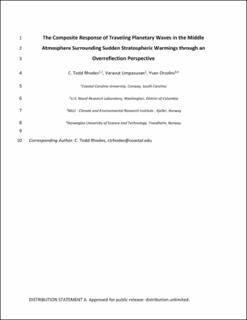| dc.contributor.author | Rhodes, Christian Todd | |
| dc.contributor.author | Limpasuvan, Varavut | |
| dc.contributor.author | Orsolini, Yvan Joseph Georges Emile G. | |
| dc.date.accessioned | 2023-11-21T15:11:10Z | |
| dc.date.available | 2023-11-21T15:11:10Z | |
| dc.date.created | 2023-09-20T11:34:52Z | |
| dc.date.issued | 2023 | |
| dc.identifier.citation | Journal of the Atmospheric Sciences. 2023, 80, 2635-2652. | en_US |
| dc.identifier.issn | 0022-4928 | |
| dc.identifier.uri | https://hdl.handle.net/11250/3103917 | |
| dc.description.abstract | Traveling planetary waves surrounding sudden stratospheric warming events can result from direct propagation from below or in situ generation. They can have significant impacts on the circulation in the mesosphere and lower thermosphere. Our study runs a series of ensembles initialized from the Whole Atmosphere Community Climate Model, Version 4, nudged up to 50 km by six-hourly Modern-Era Retrospective Analysis for Research and Application, Version 2, reanalysis to compile a library of sudden stratospheric warming events. To our knowledge, we present the first composite or ensemble study that attempts to link direct propagation and in situ generation by evaluating the wave geometries associated with the overreflection perspective, a framework used to describe how planetary waves interact with critical and turning levels. The present study looks at the evolution of these interactions through the onset of sudden stratospheric warmings with an elevated stratopause or ES-SSWs. Robust and unique features of ES-SSWs are determined by employing an ensemble study that compares ES-SSWs with normal winters. Our study evaluates the production and impacts of westward-propagating, quasi-stationary, and eastward-propagating planetary waves surrounding ES-SSWs. Our results show that eastward-propagating planetary waves are generated within the westward stratospheric wind layer after ES-SSW onset which aids in restoring the eastward stratospheric wind. The interaction of quasi-stationary and westward-propagating waves with the westward stratospheric wind is explored from an overreflection perspective and reaffirms that westward-propagating planetary waves are produced from instabilities at the top of the westward stratospheric wind reversal. | en_US |
| dc.language.iso | eng | en_US |
| dc.rights | Navngivelse 4.0 Internasjonal | * |
| dc.rights.uri | http://creativecommons.org/licenses/by/4.0/deed.no | * |
| dc.title | The Composite Response of Traveling Planetary Waves in the Middle Atmosphere Surrounding Sudden Stratospheric Warmings through an Overreflection Perspective | en_US |
| dc.title.alternative | The Composite Response of Traveling Planetary Waves in the Middle Atmosphere Surrounding Sudden Stratospheric Warmings through an Overreflection Perspective | en_US |
| dc.type | Peer reviewed | en_US |
| dc.type | Journal article | en_US |
| dc.description.version | acceptedVersion | en_US |
| dc.rights.holder | © 2023 American Meteorological Society. | en_US |
| dc.source.pagenumber | 2635-2652 | en_US |
| dc.source.volume | 80 | en_US |
| dc.source.journal | Journal of the Atmospheric Sciences | en_US |
| dc.identifier.doi | 10.1175/JAS-D-22-0266.1 | |
| dc.identifier.cristin | 2176961 | |
| dc.relation.project | NILU - Norsk institutt for luftforskning: 122069 | en_US |
| cristin.ispublished | false | |
| cristin.fulltext | original | |
| cristin.fulltext | postprint | |
| cristin.qualitycode | 2 | |

